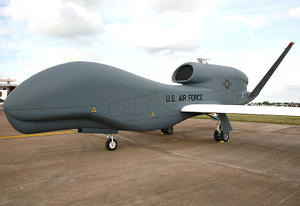UAV updatePentagon: Global Hawk Drone “not operationally effective”
The Pentagon has declared the latest Northrop Grumman Global Hawk drone “not operationally effective”; according to a report by the Pentagon’s weapon testers, the RQ-4B Global Hawk Block 30 could only provide 40 percent of the coverage requested; “Mission-critical components fail at high rates, resulting in poor takeoff reliability, high air abort rates, low mission capable rates, an excessive demand for critical spare parts and a high demand for maintenance support”; Pentagon officials declined to discuss the drone in too much detail but did say that they were working with Northrop Grumman to make improvements to the drone; defense officials have scheduled a production meeting for this month to discuss the program

Troubled Global Hawk on the tarmac // Source: airplane-pictures.net
The Pentagon has declared the latest Northrop Grumman Global Hawk drone “not operationally effective.”
According to a report signed by J. Michael Gilmore, the director of operational test and evaluation for the Department of Defense, the RQ-4B Global Hawk Block 30 could only provide 40 percent of the coverage requested.
The drones were originally designed to take detailed photos of ground targets from high altitudes and collect signals intelligence, but the report found that they were “not operationally effective for conducting near-continuous, persistent” intelligence, surveillance and reconnaissance (ISR) missions.
It went on to state that the system “is not operationally suitable,” because the “Global Hawk long endurance flights do not routinely provide persistent ISR coverage due to low air vehicle reliability.”
“Mission-critical components fail at high rates, resulting in poor takeoff reliability, high air abort rates, low mission capable rates, an excessive demand for critical spare parts and a high demand for maintenance support,” the report said.
Tests were conducted using three aircraft that flew two to three sorties a week from October through December of last year.
So far the Air Force has purchased sixteen out of the forty-two planned Global Hawk drones and it would cost an estimated $3.08 billion to purchase the remaining twenty-six drones.
Given the test results the fate of the drone is uncertain as approval from the Pentagon’s weapon testers was needed before the project could move into full production.
Pentagon officials declined to discuss the drone in too much detail.
Lieutenant Colonel Jack Miller, a spokesman for the Air Force, said the test results “will help the Air Force and Northrop Grumman implement the improvements that will increase Global Hawk’s value.”
Meanwhile Brandon Belote, the vice president of strategic communications for Northrop Grumman, said, “We are working with our customer on a coordinated response and have no immediate comment.”
Margaret Mitchell- Jones, a spokeswoman for the company, added that the Northrop is working with the Air Force “to ensure Global Hawk meets its costs and capability requirements.”
The Global Hawk drone program has exceeded its original procurement costs by more than $20 million, jumping from $90.8 million to $113.9 million. In addition, the average cost of the drones has increased by more than 25 percent. Factoring in research, development, and construction costs, the cost of each aircraft comes out to about $173 million.
Robert Stallard, a defense analyst with RBC Capital Markets, said that the latest test results are another indicator of the drone’s many failures.
“I’m afraid this is the latest in a litany of less than glowing commentary on the Global Hawk,” he said.
“I remember when unmanned aerial vehicles like this were pitched as being cheaper and more effective than manned platforms. Now the DoD appears to be saying that this is not the case in either situation, which I’d say is a real disappointment for Northrop,” Stallard said. “This is their major UAV platform, after all.’’
The Pentagon report points to several problems with the drone’s airframe and sensor equipment including frequent failures in mission-critical components like the navigational unit, the electrical generator, and adhesives used to secure nut plates. These problems have resulted in delayed takeoffs or canceled missions.
The report did offer recommendations to improve the plane and concluded that the plane’s shortcomings were “not a permanent condition” if the Air Force took “strong corrective actions.”
To improve the operational effectiveness of the Global Hawk drone, the report made sixteen recommendations including the development of de-icing systems to increase all-weather capabilities, upgrading communication systems, and the improvement of operator training programs.
In recent months, early Block 30 Global Hawks have been flown over Japan’s Fukushima Daiichi nuclear plant to take thermal images as well in Libya to conduct ground surveillance missions.
Defense officials have scheduled a production meeting for this month to discuss the Global Hawk drone program.
